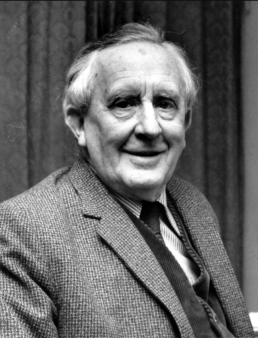These life stories may contain descriptions of childhood trauma and abuse, as well as images, voices and names of people now deceased. If you need help, you can find contact details for some relevant support services on our support page.
English writer best known for The Lord of the Rings, J.R.R. Tolkien (1892-1973), was in kinship and foster care as a child.
John Ronald Reuel Tolkien was born in the Orange Free State, South Africa. His father, Arthur Reuel Tolkien, a bank clerk, died in South Africa in 1896 and his mother, Mabel, returned to England to live near Birmingham with Ronald (as he was known in the family) and his younger brother, Hilary.
The West Midlands in Tolkien’s childhood were a complex mixture of the grimly industrial Birmingham conurbation, and the quintessentially rural stereotype of England, Worcestershire and surrounding areas…Tolkien’s life was split between these two: the then very rural hamlet of Sarehole, with its mill, just south of Birmingham; and darkly urban Birmingham itself… (Doughan).
Mabel converted to Catholicism in 1900, which resulted in estrangement from both sides of the extended family. Ronald and his brother remained Catholic throughout their lives.
When Ronald’s mother died in 1904, her sons were made wards of a Catholic priest, Francis Morgan. The boys could not live with Father Francis at the Birmingham Oratory and so he organised for them to be cared for elsewhere.
First, they lived with their aunt Beatrice who, as a recent widow, found it difficult to deal with them so they slept and ate with their aunt, but spent most of their non-school time with Father Francis.
In 1908, Father Francis moved the boys to the home of a Mrs Faulkner as he was concerned with their unhappiness in staying with Beatrice. At Mrs Faulkner’s, Ronald met his future wife, Edit Bratt, the inspiration for his characters Luthien Tinuviel and Arwen Evenstar.
Ronald went to school at St Edward’s in Birmingham before going on to Exeter College in Oxford where he attained a first in 1915. He then enlisted in the infantry and was sent to the front lines in 1916.
Tolkien taught English language literature at the University of Leeds for five years beginning in 1920, and then at Oxford University from 1925-1959.
In a sense, in returning to Oxford as a Professor, Tolkien had come home. Although he had few illusions about the academic life as a haven of unworldly scholarship… he was nevertheless by temperament a don’s don, and fitted extremely well into the largely male world of teaching, research, the comradely exchange of ideas and occasional publication. In fact, his academic publication record is very sparse, something that would have been frowned upon in these days of quantitative personnel evaluation (Doughan).
Outside of his academic life, Tolkien wrote fantasies, some to entertain his four children. The longest of these, The Hobbit, was published in 1937.
It immediately scored a success, and has not been out of children’s recommended reading lists ever since. It was so successful that Stanley Unwin asked if he had any more similar material available for publication (Doughan).
The Lord of the Rings, widely recognised as a masterpiece, was published during 1954 and 1955. By the beginning of the 21st century, more than fifty million copies had been sold.
Among the chief accomplishments in our growing appreciation of J.R.R. Tolkien’s The Lord of the Rings is the consensus view that it is indubitably a Christian epic…If Tolkien had enjoyed several more lives beyond his allotted 81, he might have extended his mythological project to include the incarnation, crucifixion, resurrection – perhaps even providing a foretaste of life in the world to come (Wood).
New Zealand director, Peter Jackson, adapted The Lord of the Rings for film, and released it in three parts from 2001 to 2003. The three movies – all filmed in New Zealand – were commercially and critically successful.
Peter Jackson also adapted The Hobbit into a series of three films made in New Zealand between 2012 and 2014.
Amazon Prime released The Lord of the Rings: The Rings of Power on 1 September 2022, a seven-episode series based on The Lord of the Rings.
References:
Doughan, David. “Who was Tolkien?” The Tolkien Society. https://www.tolkiensociety.org/author/biography/
Hammond, Wayne. “J.R.R. Tolkien English Author.” Britannica. https://www.britannica.com/biography/J-R-R-Tolkien
Jones, Lesley. J.R.R. Tolkien: A biography. Greenwood Publishing Group, 2003.
Mullan, John. “Tolkien’s first words.” Newstatesman America, 17 April 2019. https://www.newstatesman.com/culture/2019/04/tolkiens-first-words
Sheldon, Natasha. “How JRR Tolkien’s Relationship with Edit Bratt Inspired and Echoed a Tale of Middle Earth. History Collection.” https://historycollection.com/how-jrr-tolkiens-relationship-with-edith-bratt-inspired-and-echoed-a-tale-of-middle-earth/
Wood, Ralph. “‘Sad, but Not Unhappy’: J.R.R. Tolkien’s Sorrowful Vision of Joy.” ABC Religion & Ethics, 2 June 2014. https://www.abc.net.au/religion/sad-but-not-unhappy-jrr-tolkiens-sorrowful-vision-of-joy/10099240
Image available here.
